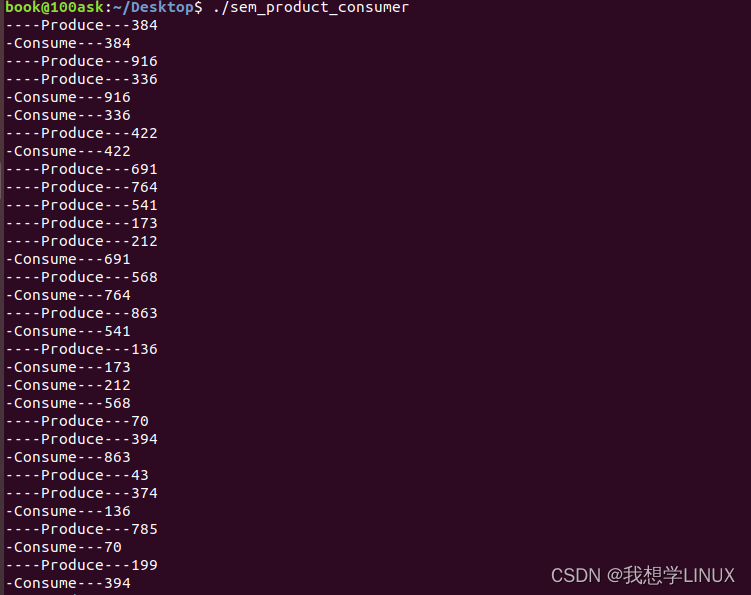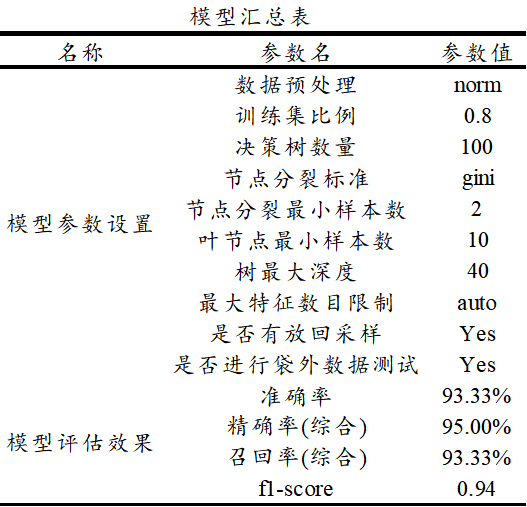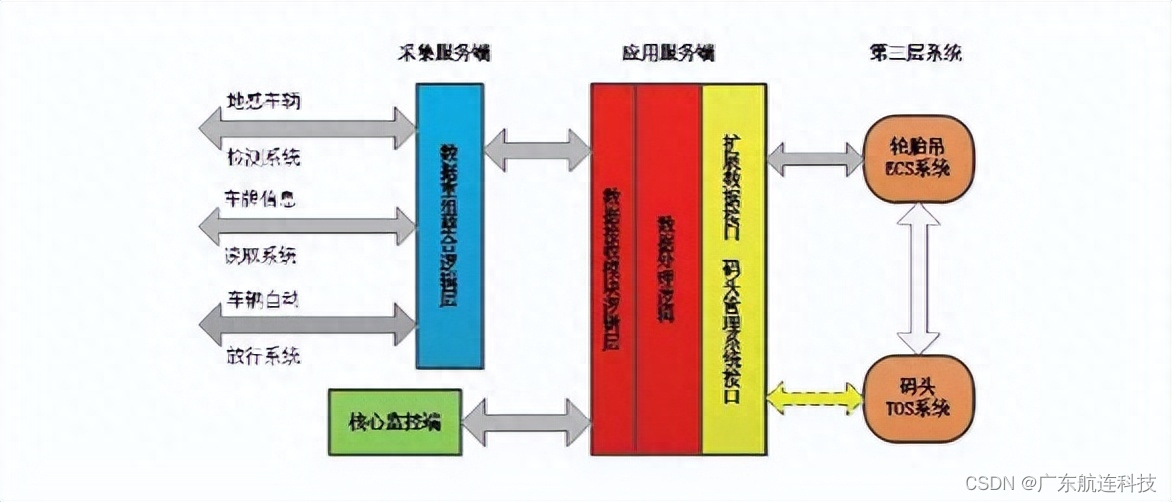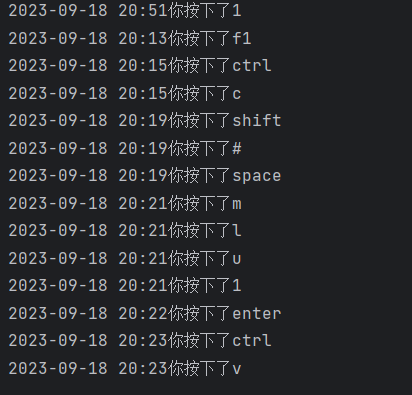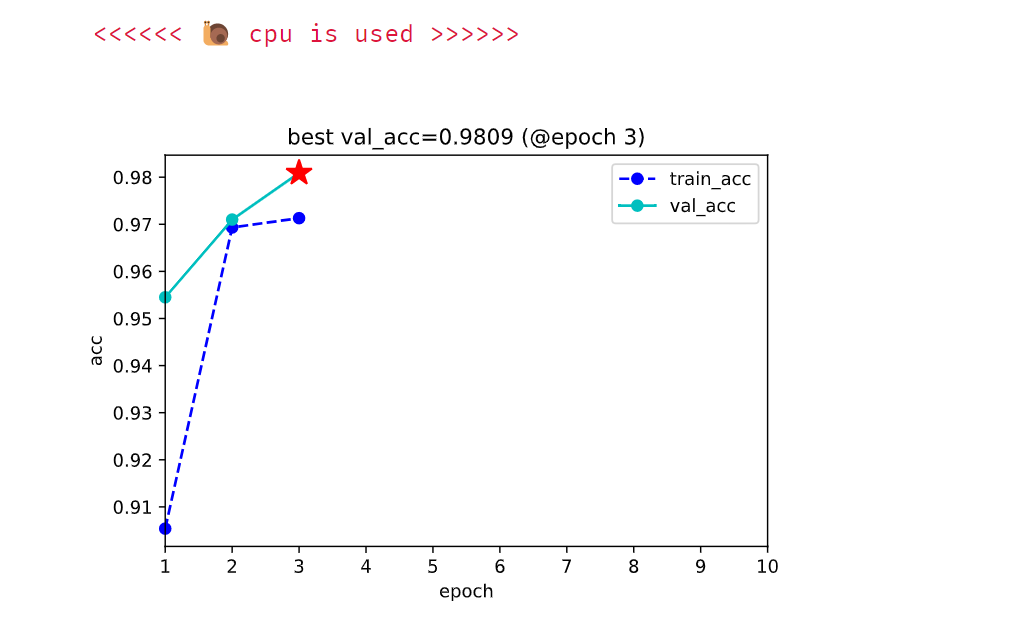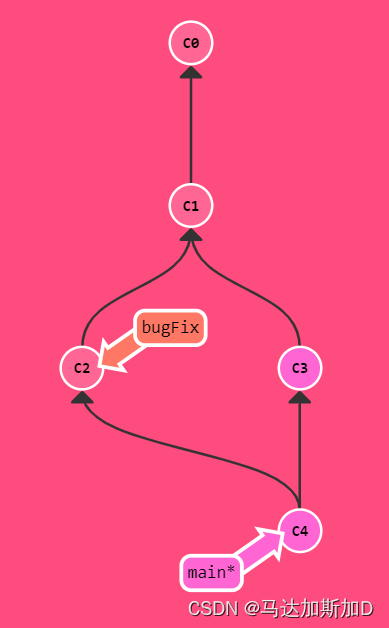前言:
在多线程编程中,如果多个线程同时访问和修改共享资源,可能会产生竞争条件和数据不一致的问题。同步机制用于协调线程之间的访问和操作,确保数据的正确性和一致性。为了避免多个线程同时访问和操作共享资源导致的问题,可以使用互斥锁(mutex)来实现线程的互斥访问。互斥锁可以保证同一时间只有一个线程访问共享资源、条件变量用于线程之间的通信和同步。一个线程可以等待某个条件成立,而其他线程可以通过发送信号来改变条件变量的状态,从而唤醒等待的线程。读写锁是一种特殊的锁,用于控制对共享资源的读取和写入。多个线程可以同时进行读操作,但只能有一个线程进行写操作,以确保数据的一致性。
目录
一、同步概念:
1.线程同步:
2.数据混乱原因:
二、互斥量 mutex
1.线程同步与锁:
2.锁的使用注意事项
3.借助互斥锁管理共享数据实现同步
(1)不加锁:
(2)加mutex:
1)使用mutex(互斥量、互斥锁)一般步骤:
2)初始化互斥量:
3)*注意事项:
(3)加锁步骤测试:
三、读写锁:
1.读写锁函数原型:
2.读写锁原理:
四、**死锁:
五、条件变量
1.初始化条件变量:
2.阻塞等待条件:
3.能够借助条件变量,完成生成者消费者
(1)模型分析
(2)代码实现
(3)运行效果编辑
(4)一个生产者,多个消费者
4.条件变量的优点:
六、信号量:
1.基本操作
2.生产者消费者信号量模型
一、同步概念:
所谓同步,即同时起步,协调一致。不同的对象,对“同步”的理解方式略有不同。如,设备同步,是指在两 个设备之间规定一个共同的时间参考;数据库同步,是指让两个或多个数据库内容保持一致,或者按需要部分保持 一致;文件同步,是指让两个或多个文件夹里的文件保持一致。等等
而,编程中、通信中所说的同步与生活中大家印象中的同步概念略有差异。“同”字应是指协同、协助、互相 配合。主旨在协同步调,按预定的先后次序运行
1.线程同步:
协同步调,对公共区域数据按序访问。防止数据混乱,产生与时间有关的错误。
因此,所有“多个控制流,共同操作一个共享资源”的情况,都需要同步
2.数据混乱原因:
1. 资源共享(独享资源则不会)
2. 调度随机(意味着数据访问会出现竞争)
3. 线程间缺乏必要的同步机制。
以上 3 点中,前两点不能改变,欲提高效率,传递数据,资源必须共享。只要共享资源,就一定会出现竞争。 只要存在竞争关系,数据就很容易出现混乱。
二、互斥量 mutex
Linux 中提供一把互斥锁 mutex(也称之为互斥量)。
每个线程在对资源操作前都尝试先加锁,成功加锁才能操作,操作结束解锁。
资源还是共享的,线程间也还是竞争的, 但通过“锁”就将资源的访问变成互斥操作,而后与时间有关的错误也不会再产生了。

1.线程同步与锁:
“与时间有关的错误”(time related)。为了避免这种数据混乱,线程需要同步。

2.锁的使用注意事项
建议锁!对公共数据进行保护。所有线程【应该】在访问公共数据前先拿锁再访问。但锁本身不具备强制性。

3.借助互斥锁管理共享数据实现同步
(1)不加锁:
#include <stdio.h>
#include <string.h>
#include <pthread.h>
#include <stdlib.h>
#include <unistd.h>
void *tfn(void *arg)
{
srand(time(NULL));
while (1) {
printf("hello ");
sleep(rand() % 3); //模拟长时间操作共享资源,导致cpu易主,产生与时间有关的错误
printf("world\n");
sleep(rand() % 3);
}
return NULL;
}
int main(void)
{
pthread_t tid;
srand(time(NULL));
pthread_create(&tid, NULL, tfn, NULL);
while (1) {
printf("HELLO ");
sleep(rand() % 3);
printf("WORLD\n");
sleep(rand() % 3);
}
pthread_join(tid, NULL);
return 0;
}
/*线程之间共享资源stdout*/
子父线程相互争夺cpu,出现数据混淆现象:
(2)加mutex:
1)使用mutex(互斥量、互斥锁)一般步骤:
pthread_mutex_t 类型。(本质是结构体)
1. pthread_mutex_t lock; 创建锁
2 pthread_mutex_init; 初始化 1
3. pthread_mutex_lock;加锁 1-- --> 0
4. 访问共享数据(stdout)
5. pthrad_mutext_unlock();解锁 0++ --> 1
6. pthead_mutex_destroy;销毁锁
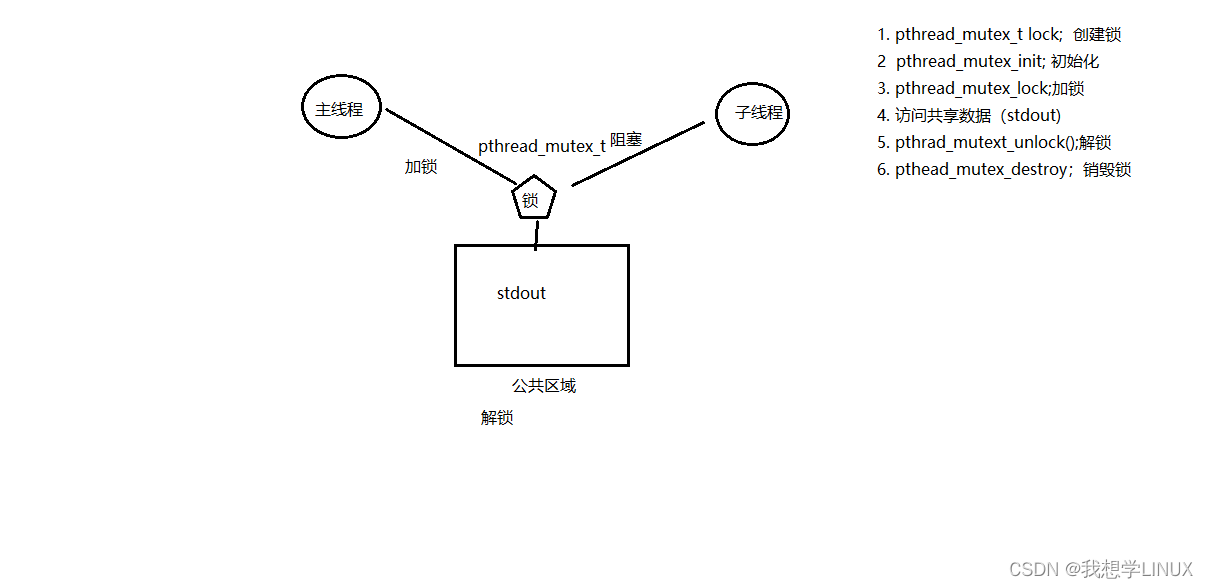
2)初始化互斥量:
pthread_mutex_t mutex;
1. pthread_mutex_init(&mutex, NULL); 动态初始化。
2. pthread_mutex_t mutex = PTHREAD_MUTEX_INITIALIZER; 静态初始化。
3)*注意事项:
尽量保证锁的粒度, 越小越好。(访问共享数据前加锁。访问结束【立即】解锁。)
互斥锁,本质是结构体。 我们可以看成整数。 初值为 1。(pthread_mutex_init() 函数调用成功。)
加锁:--操作, 阻塞线程。
解锁:++操作, 换醒阻塞在锁上的线程。
try锁: 尝试加锁,成功--。失败,返回。同时设置错误号 EBUSY
restrict关键字: 用来限定指针变量。被该关键字限定的指针变量所指向的内存操作,必须由本指针完成
(3)加锁步骤测试:
#include <stdio.h>
#include <string.h>
#include <pthread.h>
#include <stdlib.h>
#include <unistd.h>
pthread_mutex_t mutex; //定义一把互斥锁,可以想象为一个int
void *tfn(void *arg)
{
srand(time(NULL));
while (1) {
pthread_mutex_lock(&mutex); //加锁 可以想象成锁-- (1------- -->0)
printf("hello ");
sleep(rand() % 3); //模拟长时间操作共享资源,导致cpu易主,产生与时间有关的错误
printf("world\n");
pthread_mutex_unlock(&mutex); //解锁 可以想象为锁++ (0------- -->1)
sleep(rand() % 3);
}
return NULL;
}
int main(void)
{
pthread_t tid;
srand(time(NULL));
int ret = pthread_mutex_init(&mutex,NULL); //初始化互斥锁 可以认为锁的值为1
if(ret != 0){
fprintf(stderr,"mutex init error: %s\n",strerror(ret));
exit(1);
}
pthread_create(&tid, NULL, tfn, NULL);
while (1) {
pthread_mutex_lock(&mutex); //加锁 可以想象成锁-- (1------- -->0)
printf("HELLO ");
sleep(rand() % 3);
printf("WORLD\n");
pthread_mutex_unlock(&mutex); //解锁 可以想象为锁++ (0------- -->1)
sleep(rand() % 3);
}
pthread_join(tid, NULL);
pthread_mutex_destroy(&mutex); //销毁互斥锁
return 0;
}
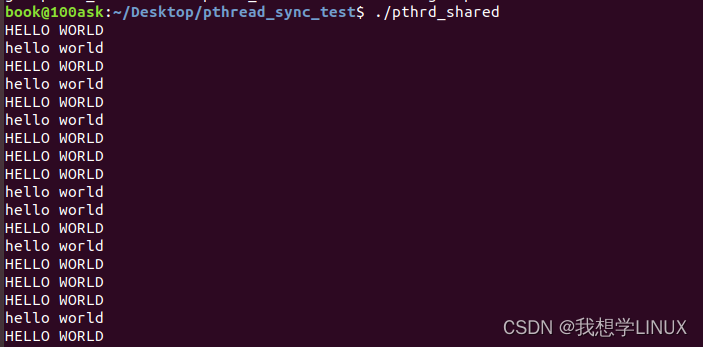
三、读写锁:
1.读写锁函数原型:
锁只有一把。以读方式给数据加锁——读锁。以写方式给数据加锁——写锁。
读共享,写独占。
写锁优先级高。
相较于互斥量而言,当读线程多的时候,提高访问效率
pthread_rwlock_t rwlock;
pthread_rwlock_init(&rwlock, NULL); //初始化读写锁
pthread_rwlock_rdlock(&rwlock); try //读模式加锁
pthread_rwlock_wrlock(&rwlock); try //写模式加锁
pthread_rwlock_unlock(&rwlock); //解锁
pthread_rwlock_destroy(&rwlock);· //销毁读写锁
2.读写锁原理:

同时有多个线程对同一全局数据读、写操作
/* 3个线程不定时 "写" 全局资源,5个线程不定时 "读" 同一全局资源 */
#include <stdio.h>
#include <unistd.h>
#include <pthread.h>
int counter; //全局资源
pthread_rwlock_t rwlock; //全局的读写锁
void *th_write(void *arg)
{
int t;
int i = (int)arg;
while (1) {
t = counter; // 保存写之前的值
usleep(1000);
pthread_rwlock_wrlock(&rwlock); //以写模式加锁,写独占
printf("=====write %d: %lu: counter=%d ++counter=%d\n", i, pthread_self(), t, ++counter);
pthread_rwlock_unlock(&rwlock); //解锁
usleep(9000); // 给 r 锁提供机会
}
return NULL;
}
void *th_read(void *arg)
{
int i = (int)arg;
while (1) {
pthread_rwlock_rdlock(&rwlock); //读线程间,读锁共享
printf("-----------------read %d: %lu: %d\n", i, pthread_self(), counter);
pthread_rwlock_unlock(&rwlock); //解锁
usleep(2000); // 给写锁提供机会
}
return NULL;
}
int main(void)
{
int i;
pthread_t tid[8]; //设置一个8个线程的数组
pthread_rwlock_init(&rwlock, NULL); //自定义读写锁
for (i = 0; i < 3; i++)
pthread_create(&tid[i], NULL, th_write, (void *)i); //创建3个写线程
for (i = 0; i < 5; i++)
pthread_create(&tid[i+3], NULL, th_read, (void *)i); //创建5个读线程
for (i = 0; i < 8; i++)
pthread_join(tid[i], NULL); //回收8个线程
pthread_rwlock_destroy(&rwlock); //释放读写琐
return 0;
}

四、**死锁:
是使用锁不恰当导致的现象:
1. 对一个锁反复lock。
2. 两个线程,各自持有一把锁,请求另一把。

五、条件变量
本身不是锁! 但是通常结合锁来使用。 mutex
pthread_cond_t cond;
1.初始化条件变量:
1. pthread_cond_init(&cond, NULL); 动态初始化。
2. pthread_cond_t cond = PTHREAD_COND_INITIALIZER; 静态初始化。
2.阻塞等待条件:
pthread_cond_wait(&cond, &mutex);
作用:
1) 阻塞等待条件变量满足
2) 解锁已经加锁成功的信号量 (相当于 pthread_mutex_unlock(&mutex))
3) 当条件满足,函数返回时,重新加锁信号量 (相当于, pthread_mutex_lock(&mutex);)
1) 和 2)俩步为一个原子操作
pthread_cond_signal(): 唤醒阻塞在条件变量上的 (至少)一个线程。
pthread_cond_broadcast(): 唤醒阻塞在条件变量上的所有线程。
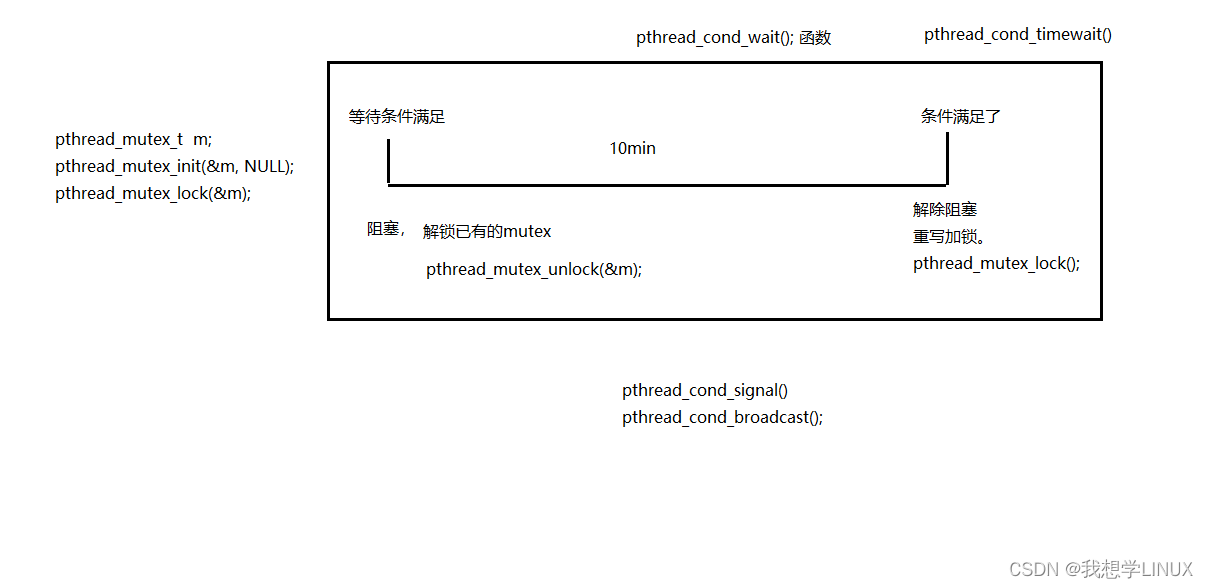
3.能够借助条件变量,完成生成者消费者
(1)模型分析
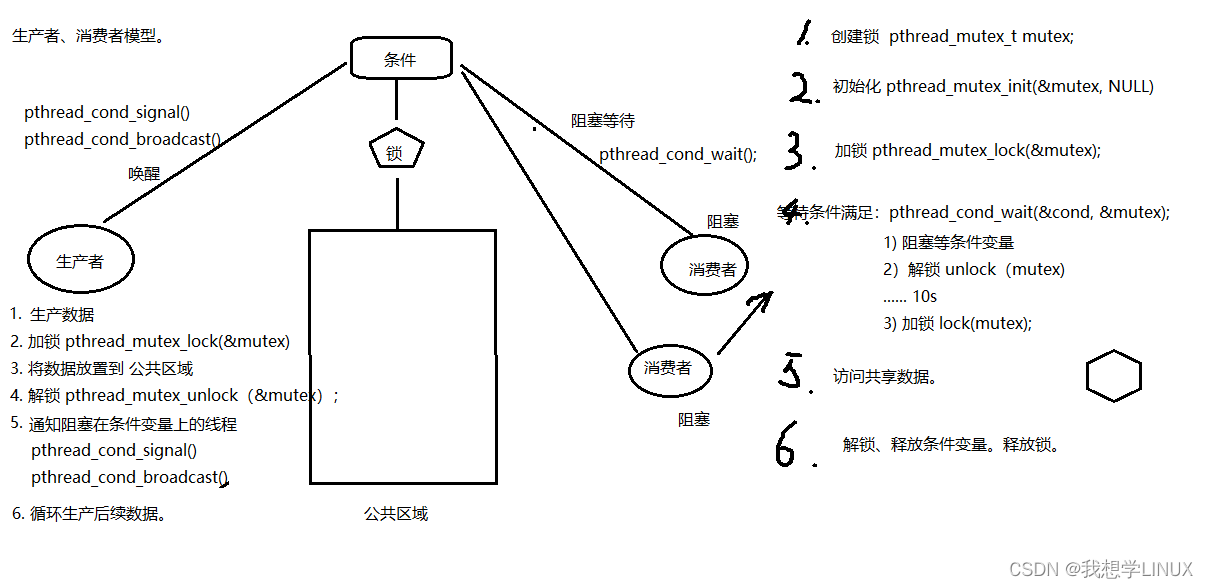
(2)代码实现
/*借助条件变量模拟 生产者-消费者 问题*/
#include <stdlib.h>
#include <unistd.h>
#include <pthread.h>
#include <stdio.h>
/*链表作为公享数据,需被互斥量保护*/
struct msg {
struct msg *next;
int num;
};
struct msg *head;
/* 静态初始化 一个条件变量 和 一个互斥量*/
pthread_cond_t has_product = PTHREAD_COND_INITIALIZER;
pthread_mutex_t lock = PTHREAD_MUTEX_INITIALIZER;
void *consumer(void *p)//消费者函数
{
struct msg *mp;
for (;;) {
pthread_mutex_lock(&lock);
while (head == NULL) { //头指针为空,说明没有节点 可以为if吗
pthread_cond_wait(&has_product, &lock);//发生阻塞
}
mp = head;
head = mp->next; //模拟消费掉一个产品
pthread_mutex_unlock(&lock);
printf("-Consume %lu---%d\n", pthread_self(), mp->num);
free(mp);
sleep(rand() % 5);
}
}
void *producer(void *p)//生产者函数
{
struct msg *mp;
for (;;) {
mp = malloc(sizeof(struct msg));
mp->num = rand() % 1000 + 1; //模拟生产一个产品
printf("-Produce ---------------------%d\n", mp->num);
pthread_mutex_lock(&lock);
mp->next = head;
head = mp;
pthread_mutex_unlock(&lock);
pthread_cond_signal(&has_product); //将等待在该条件变量上的 一个线程唤醒
sleep(rand() % 5);
}
}
int main(int argc, char *argv[])
{
pthread_t pid, cid;
srand(time(NULL));
pthread_create(&pid, NULL, producer, NULL);//创建生产者
pthread_create(&cid, NULL, consumer, NULL);//创建消费者
pthread_join(pid, NULL);//回收生产者
pthread_join(cid, NULL);//回收消费者
return 0;
}
(3)运行效果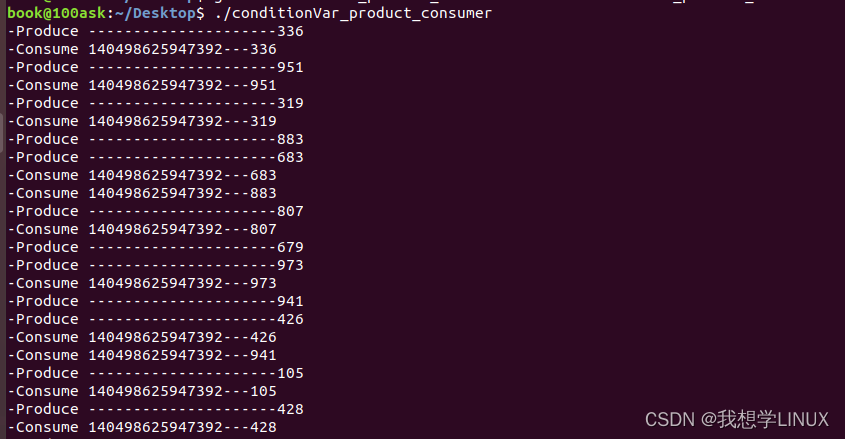
(4)一个生产者,多个消费者
#include <stdio.h>
#include <stdlib.h>
#include <string.h>
#include <unistd.h>
#include <errno.h>
#include <pthread.h>
void err_thread(int ret, char *str)
{
if (ret != 0) {
fprintf(stderr, "%s:%s\n", str, strerror(ret));
pthread_exit(NULL);
}
}
struct msg {
int num;
struct msg *next;
};
struct msg *head;
pthread_mutex_t mutex = PTHREAD_MUTEX_INITIALIZER; // 定义/初始化一个互斥量
pthread_cond_t has_data = PTHREAD_COND_INITIALIZER; // 定义/初始化一个条件变量
void *produser(void *arg)
{
while (1) {
struct msg *mp = malloc(sizeof(struct msg));
mp->num = rand() % 1000 + 1; // 模拟生产一个数据`
printf("--produce %d\n", mp->num);
pthread_mutex_lock(&mutex); // 加锁 互斥量
mp->next = head; // 写公共区域
head = mp;
pthread_mutex_unlock(&mutex); // 解锁 互斥量
pthread_cond_signal(&has_data); // 唤醒阻塞在条件变量 has_data上的线程.
sleep(rand() % 3);
}
return NULL;
}
void *consumer(void *arg)
{
while (1) {
struct msg *mp;
pthread_mutex_lock(&mutex); // 加锁 互斥量
while (head == NULL) {
pthread_cond_wait(&has_data, &mutex); // 阻塞等待条件变量, 解锁
} // pthread_cond_wait 返回时, 重新加锁 mutex
mp = head;
head = mp->next;
pthread_mutex_unlock(&mutex); // 解锁 互斥量
printf("---------consumer id: %lu :%d\n", pthread_self(), mp->num);
free(mp);
sleep(rand()%3);
}
return NULL;
}
int main(int argc, char *argv[])
{
int ret;
pthread_t pid, cid;
srand(time(NULL));
ret = pthread_create(&pid, NULL, produser, NULL); // 生产者
if (ret != 0)
err_thread(ret, "pthread_create produser error");
ret = pthread_create(&cid, NULL, consumer, NULL); // 消费者
if (ret != 0)
err_thread(ret, "pthread_create consuer error");
ret = pthread_create(&cid, NULL, consumer, NULL); // 消费者
if (ret != 0)
err_thread(ret, "pthread_create consuer error");
ret = pthread_create(&cid, NULL, consumer, NULL); // 消费者
if (ret != 0)
err_thread(ret, "pthread_create consuer error");
pthread_join(pid, NULL);
pthread_join(cid, NULL);
return 0;
}

4.条件变量的优点:
相较于 mutex 而言,条件变量可以减少竞争。
如直接使用 mutex,除了生产者、消费者之间要竞争互斥量以外,消费者之间也需要竞争互斥量,但如果汇聚 (链表)中没有数据,消费者之间竞争互斥锁是无意义的。有了条件变量机制以后,只有生产者完成生产,才会引 起消费者之间的竞争。提高了程序效率
六、信号量:
1.基本操作
应用于线程、进程间同步。
相当于 初始化值为 N 的互斥量。 N值,表示可以同时访问共享数据区的线程数。
函数:
sem_t sem; 定义类型。
int sem_init(sem_t *sem, int pshared, unsigned int value);//初始化信号量
参数:
sem: 信号量
pshared: 0: 用于线程间同步
1: 用于进程间同步
value: N值:(指定同时访问的线程数)
sem_destroy(); //销毁信号量
sem_wait(); 一次调用,做一次-- 操作, 当信号量的值为 0 时,再次 -- 就会阻塞。 (对比 pthread_mutex_lock)//加锁
sem_post(); 一次调用,做一次++ 操作. 当信号量的值为 N 时, 再次 ++ 就会阻塞。(对比 pthread_mutex_unlock)//解锁
注意:信号量的初值,决定了占用信号量的线程个数
2.生产者消费者信号量模型
使用信号量完成线程间同步,模拟生产者,消费者问题
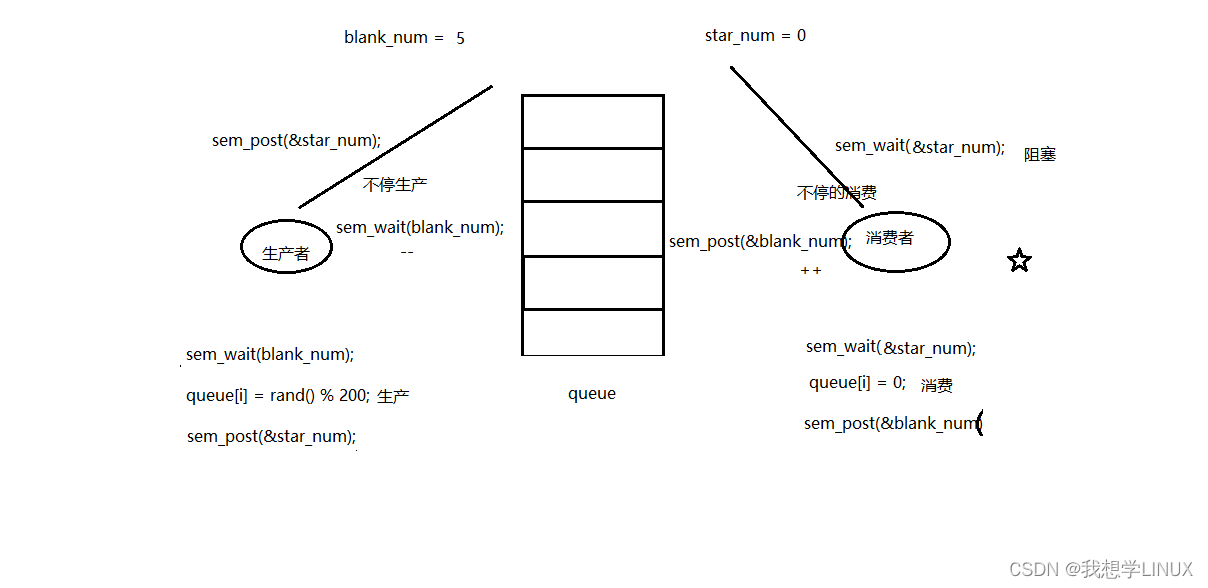
/*信号量实现 生产者 消费者问题*/
#include <stdlib.h>
#include <unistd.h>
#include <pthread.h>
#include <stdio.h>
#include <semaphore.h>
#define NUM 5
int queue[NUM]; //全局数组实现环形队列
sem_t blank_number, product_number; //空格子信号量, 产品信号量
void *producer(void *arg)
{
int i = 0;
while (1) {
sem_wait(&blank_number); //生产者将空格子数--,为0则阻塞等待
queue[i] = rand() % 1000 + 1; //生产一个产品
printf("----Produce---%d\n", queue[i]);
sem_post(&product_number); //将产品数++
i = (i+1) % NUM; //借助下标实现环形
sleep(rand()%1);
}
}
void *consumer(void *arg)
{
int i = 0;
while (1) {
sem_wait(&product_number); //消费者将产品数--,为0则阻塞等待
printf("-Consume---%d\n", queue[i]);
queue[i] = 0; //消费一个产品
sem_post(&blank_number); //消费掉以后,将空格子数++
i = (i+1) % NUM;
sleep(rand()%3);
}
}
int main(int argc, char *argv[])
{
pthread_t pid, cid;
sem_init(&blank_number, 0, NUM); //初始化空格子信号量为5, 线程间共享 -- 0
sem_init(&product_number, 0, 0); //产品数为0
pthread_create(&pid, NULL, producer, NULL); //产生生产者
pthread_create(&cid, NULL, consumer, NULL); //产生消费者
pthread_join(pid, NULL);
pthread_join(cid, NULL);
sem_destroy(&blank_number); //回收生产者
sem_destroy(&product_number); //回收消费者
return 0;
}
